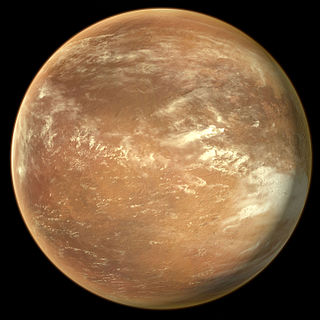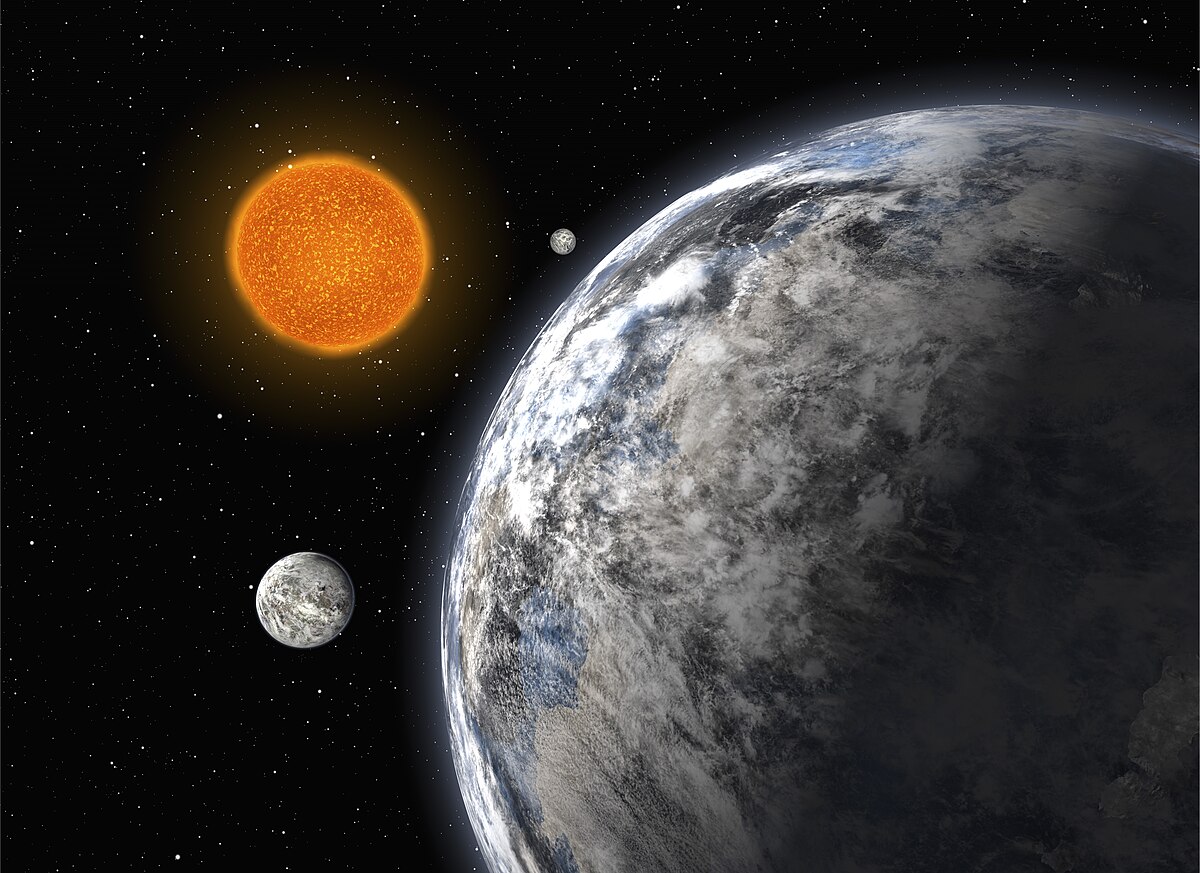Mu Arae, often designated HD 160691, officially named Cervantessur-VAN-teez, is a main sequence G-type star approximately 50 light-years away from the Sun in the constellation of Ara. The star has a planetary system with four known extrasolar planets, three of them with masses comparable with that of Jupiter. Mu Arae c, the innermost, was the first hot Neptune or super-Earth discovered.
HD 169830 is a star in the southern constellation of Sagittarius. It has a yellow-white hue and is dimly visible to the naked eye with an apparent visual magnitude of +5.90. The star is located at a distance of 120 light years from the Sun based on parallax. It is drifting closer with a radial velocity of −17.3 km/s, and is predicted to come as close as 20.7 ly (6.4 pc) in 2.08 million years. HD 169830 is known to be orbited by two large Jupiter-like exoplanets.
HD 114386 is a star with a pair of orbiting exoplanets in the southern constellation of Centaurus. It has an apparent visual magnitude of 8.73, which means it cannot be viewed with the naked eye but can be seen with a telescope or good binoculars. Based on parallax measurements, the system is located at a distance of 91 light years from the Sun. It is receding with a radial velocity of 33.4 km/s. The star shows a high proper motion, traversing the celestial sphere at an angular rate of 0.318 arcsec yr−1.

HD 28185 b is an extrasolar planet 128 light-years away from Earth in the constellation of Eridanus. The planet was discovered orbiting the Sun-like star HD 28185 in April 2001 as a part of the CORALIE survey for southern extrasolar planets, and its existence was independently confirmed by the Magellan Planet Search Survey in 2008. HD 28185 b orbits its sun in a circular orbit that is at the inner edge of its star's habitable zone.
Pi Mensae, also known as HD 39091, is a G-dwarf star in the constellation of Mensa. This star has a high proper motion. The apparent magnitude is 5.67, which can be visible to the naked eye in exceptionally dark, clear skies. It is nearly 60 light-years away. The star is slightly larger than the Sun in terms of mass, size, luminosity, temperature and metallicity, and is about 730 million years younger. It hosts three known planets.
HIP 14810 is a star with three exoplanetary companions in the northern constellation of Aries. It positioned about 1.3° to the north of Delta Arietis, but is too faint to be visible to the naked eye with an apparent visual magnitude of 8.6. The system is located at a distance of 165 light-years from the Sun based on parallax measurements, but is drifting closer with a radial velocity of −5 km/s.
Gliese 317 is a small red dwarf star with two exoplanetary companions in the southern constellation of Pyxis. It is located at a distance of 49.6 light-years from the Sun based on parallax measurements, and is drifting further away with a radial velocity of +87.8 km/s. This star is too faint to be viewed with the naked eye, having an apparent visual magnitude of 11.98 and an absolute magnitude of 11.06.
HD 162020 is a star in the southern constellation of Scorpius with a likely red dwarf companion. It has an apparent visual magnitude of 9.10, which is too faint to be visible to the naked eye. The distance to this system is 102 light-years based on stellar parallax. It is drifting closer to the Sun with a radial velocity of −27 km/s, and is predicted to come to within ~18 light-years in 1.1 million years.

HD 40307 is an orange (K-type) main-sequence star located approximately 42 light-years away in the constellation of Pictor, taking its primary name from its Henry Draper Catalogue designation. It is calculated to be slightly less massive than the Sun. The star has six known planets, three discovered in 2008 and three more in 2012. One of them, HD 40307 g, is a potential super-Earth in the habitable zone, with an orbital period of about 200 days. This object might be capable of supporting liquid water on its surface, although much more information must be acquired before its habitability can be assessed.
HD 40307 c is an extrasolar planet orbiting the star HD 40307, located 42 light-years away in the direction of the southern constellation of Pictor. The planet was discovered by the radial velocity method, using the HARPS apparatus, in June 2008. Of the six proposed planets in the HD 40307 star system, it is the third-largest, and has the second-closest orbit from the star. The planet is of interest as this star has relatively low metallicity, supporting a hypothesis that different metallicities in protostars determine what kind of planets they will form.
HD 40307 d is an extrasolar planet orbiting the star HD 40307, located 42 light-years from Earth in the direction of the southern constellation Pictor. The planet was discovered by the radial velocity method, using the HARPS apparatus in June 2008. It is the most massive of the six proposed planets in the system. The planet is of interest as this star has relatively low metallicity, supporting a hypothesis that different metallicities in protostars determine what kind of planets they will form.
HD 47186 is a star with a pair of orbiting exoplanets in the southern constellation of Canis Major. The system is located at a distance of 122 light years from the Sun based on parallax measurements, and is drifting further away with a radial velocity of 4.2 km/s. Although it has an absolute magnitude of 4.64, at the distance of this system the apparent visual magnitude is 7.63; too faint to be seen with the naked eye. It has a high proper motion, traversing the celestial sphere at an angular rate of 0.272″·yr−1.
HD 171238 is a star with an orbiting exoplanet in the southern constellation of Sagittarius. It is located at a distance of 145 light years from the Sun based on parallax measurements, and is drifting further away with a radial velocity of 21 km/s. The star has an absolute magnitude of 5.15, but at the distance of this system it is too faint to be viewed with the naked eye, having an apparent visual magnitude of 8.61.

An exoplanet is a planet located outside the Solar System. The first evidence of an exoplanet was noted as early as 1917, but was not recognized as such until 2016; no planet discovery has yet come from that evidence. What turned out to be the first detection of an exoplanet was published among a list of possible candidates in 1988, though not confirmed until 2003. The first confirmed detection came in 1992, with the discovery of terrestrial-mass planets orbiting the pulsar PSR B1257+12. The first confirmation of an exoplanet orbiting a main-sequence star was made in 1995, when a giant planet was found in a four-day orbit around the nearby star 51 Pegasi. Some exoplanets have been imaged directly by telescopes, but the vast majority have been detected through indirect methods, such as the transit method and the radial-velocity method. As of 24 July 2024, there are 7,026 confirmed exoplanets in 4,949 planetary systems, with 1007 systems having more than one planet. This is a list of the most notable discoveries.
HD 20781 is a star which is part of a wide binary system with HD 20782. The companion star has a very large angular separation of 252 arcsec, corresponding to 9080 AU at the distance of HD 20782. Both stars possess their own planetary systems in S type orbits, with a total of five known planets around both stars. This is the first known example of planets being found orbiting both components of a wide binary system. HD 20781 has no noticeable starspot activity.

HD 40307 g is an exoplanet candidate suspected to be orbiting in the habitable zone of HD 40307. It is located 42 light-years away in the direction of the southern constellation Pictor. The planet was discovered by the radial velocity method, using the European Southern Observatory's HARPS apparatus by a team of astronomers led by Mikko Tuomi at the University of Hertfordshire and Guillem Anglada-Escude of the University of Göttingen, Germany.

HD 40307 e is an extrasolar planet candidate suspected to be orbiting the star HD 40307. It is located 42 light-years away in the direction of the southern constellation Pictor. The planet was discovered by the radial velocity method, using the European Southern Observatory's HARPS apparatus by a team of astronomers led by Mikko Tuomi at the University of Hertfordshire and Guillem Anglada-Escude of the University of Göttingen, Germany.
HD 40307 f is an extrasolar planet orbiting the star HD 40307. It is located 42 light-years away in the direction of the southern constellation Pictor. The planet was discovered by the radial velocity method, using the European Southern Observatory's HARPS apparatus by a team of astronomers led by Mikko Tuomi at the University of Hertfordshire and Guillem Anglada-Escude of the University of Göttingen, Germany. The existence of planet was confirmed in 2015.
HD 109271 is a wide binary star system in the constellation of Virgo. The brighter member of the binary has a pair of orbiting exoplanets. With an apparent visual magnitude of 8.05, it cannot be seen with the naked eye. Parallax measurements made by Gaia put the star at a distance of 181 light-years away from the Sun, but it is drifting closer with a radial velocity of −5 km/s. The system shows a high proper motion, traversing the celestial sphere at an angular rate of 0.232 arcsec yr−1.





